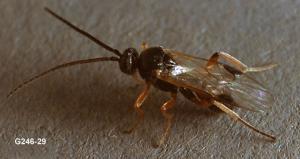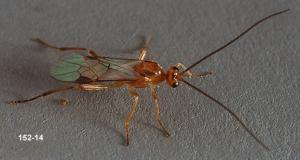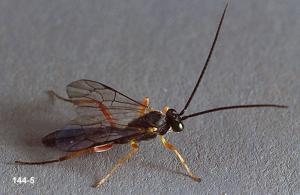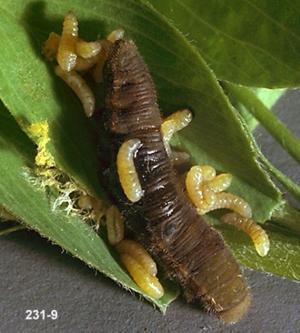Contents
Identification
Fact
Sheet (requires Acrobat Reader 3.x or
above to read and print. Click below to download the free "Reader".)

Registered
Insecticides
References
[Insect
Management]
[Home] |
|
 In most instances, development of parasite populations lags behind
that of the prey, which may result in large numbers of pests being present before
sufficient numbers of parasites are present to control pest populations. Nevertheless,
parasites are important regulating factors of pests in mint. Parasitized insects are
frequently conspicuous enough to be observed in the field - usually swollen or immobile.
If the parasite has matured, the host may be covered with tiny cocoons or it may be
hollow. Parasites of aphids form cocoons either in or under the swollen, tan,
mummified skeleton of the aphid. It is important to look for parasitized insects when
fields are being routinely sampled for the presence of pest insects. If a large number of
parasitized insects are found, it may not be necessary to treat with an insecticide. |
 
|
| Hymenoptera Parasite
Adult |
Hymenoptera Parasite
Adults |
 |
Most parasites (also called parasitoids)
are tiny wasps, which are easily overlooked. Adult parasites range in size from very small
(0.3 to 3 mm long) to 20 to 35 mm long. Most range in size from 2 to 15 mm. Larvae
of most Hymenoptera parasites develop inside the bodies of their prey, but some feed
externally or pupate outside the host's body. Most Hymenoptera parasites overwinter as
pupae or prepupae in the soil, under trash, within prey, or in other protected areas.
Adult emergence in the spring is closely synchronized with the prey. Females lay an egg in
or on the prey and the parasite larva consumes internal tissues and organs, eventually
killing the prey. Many parasites have numerous overlapping generations during the summer,
but some species have only one generation each year. These parasites are important in
suppressing populations of many insects. In mint, they are important for control of
loopers, cutworms, and aphids (see Coop and Berry, 1986). |
Hymenoptera Parasite
Larvae on Prey |
View the Fact
Sheet for More Information |
This section contains information on the
identification of Hymenoptera parasites. The Fact Sheet contains specific information on
identifcation and biology of these parasites (requires Acrobat Reader).
|




